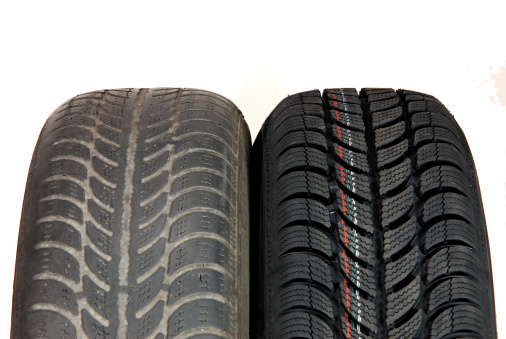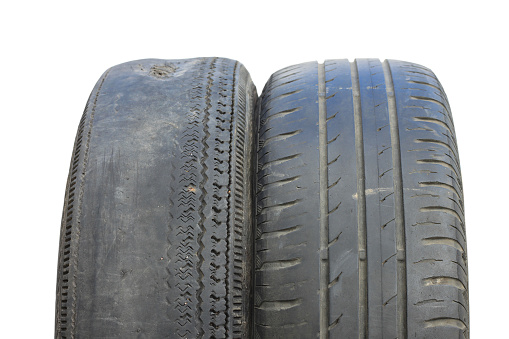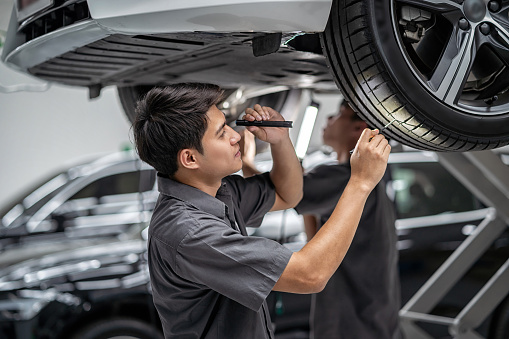As a leader in the tire repair industry, we understand the importance of your vehicle’s tires. They are, after all, your sole connection to the road. Ensuring their optimum condition is not just about enhancing your vehicle’s performance; it’s a vital aspect of road safety, fuel economy, and overall vehicle health.
Tires are your vehicle’s first line of defense on the road, making their maintenance and repair paramount for your safety and vehicle efficiency. Regular tire inspections are crucial, as they can reveal wear patterns that signify deeper vehicle issues. Understanding these tread wear patterns can guide maintenance or repairs, ensuring optimal performance and safety.
Treadwear patterns, often telltale signs of broader vehicle issues, can be interpreted through regular tire inspections. Let’s delve into what these patterns signify and how they can be effectively managed.

Worn tire tread compared to fresh tread.
The Critical Role of Tire Tread
Your tire treads are designed to provide the traction needed for safe stopping, starting, and steering, especially under challenging conditions. As treads wear down, they can compromise vehicle performance and safety. How your tire tread wears can offer important clues about your vehicle’s condition and alignment.
Need Your Tire Fixed Fast?
Find A TECH Preferred Shop Near You!
Interpreting Tire Tread Wear Patterns
Understanding your tire tread wear patterns is crucial for several reasons that contribute to safe, efficient, and cost-effective vehicle operation. Here’s why it’s essential to pay attention to your treadwear:

Safety: Tires are the only contact point between your vehicle and the road. Proper tread depth is essential for maintaining traction in various driving conditions, especially in wet or icy conditions. Identifying abnormal wear patterns early can prevent accidents caused by tire failure or inadequate road grip.
Vehicle Performance: Tires with uneven wear can lead to poor handling, increased stopping distances, and an uncomfortable ride. Understanding and addressing wear patterns can help maintain the vehicle’s performance, ensuring it handles correctly and predictably under all circumstances.
Prevent Costly Repairs: Early detection of irregular tread wear can indicate problems with the tires themselves and with other vehicle components, such as the suspension, alignment, or braking system. Addressing these issues early can prevent more significant and expensive repairs.
Increase Tire Lifespan: By monitoring tread wear and addressing issues as they arise, you can maximize the lifespan of your tires. Regular maintenance such as tire rotation, balancing, and maintaining proper inflation can correct or prevent uneven wear, thereby extending the life of the tires.
Fuel Efficiency: Improperly inflated or misaligned tires can increase rolling resistance, which requires more energy (fuel) to move and maintain the vehicle’s speed. Understanding and correcting tire wear patterns can help ensure that tires function optimally, improving fuel efficiency.
Environmental Impact: By extending tire life and improving fuel efficiency, you are also contributing to environmental conservation. Less frequent tire changes reduce waste, and better fuel efficiency decreases emissions.
Common Tire Tread Wear Patterns & Their Meanings
Even Wear: Tread wear is uniform across the tire’s surface. This is normal wear and suggests that the tires are properly inflated and aligned. Continue regular maintenance and monitor for other wear patterns.
Center Wear: The tread is more worn in the center than on the edges. This pattern typically suggests over-inflation. Reduce tire pressure to the manufacturer’s recommended levels and check if wear evens out.
Edge Wear: The tire edges are more worn than the center. This usually indicates under-inflation. Inflate the tires to the recommended pressure as specified by the manufacturer.
Cupping or Scalloping: This is often a sign of suspension issues or imbalanced wheels. Have the suspension checked and repaired, and ensure the wheels are balanced. Diagonal scallops or dips appear around the tire’s surface.
Correlation between Tire Repairs and Tread Wear
Understanding tread wear is not only crucial for maintenance but also for determining when tire repairs are necessary. Regular inspections can detect unusual wear patterns early, allowing for timely repairs, extending tire life, and enhancing safety. Certain wear patterns, like uneven or one-sided wear, can often be corrected through tire repairs such as rotation, balancing, and alignment. These repairs can prevent further damage and restore proper handling and safety. Addressing wear issues promptly through appropriate maintenance can prevent more significant expenses associated with tire replacement or vehicle damage due to poor handling.



Recent Comments